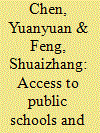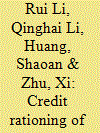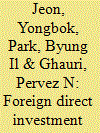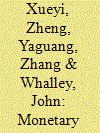|
|
|
Sort Order |
|
|
|
Items / Page
|
|
|
|
|
|
|
| Srl | Item |
| 1 |
ID:
123338


|
|
|
|
|
| Publication |
2013.
|
| Summary/Abstract |
A significant proportion of migrant children in China are not able to attend public schools for the lack of local household registration (HuKou), and turn to privately-operated migrant schools. This paper examines the consequences of such a partially involuntary school choice, using survey data and standardized test scores from field work conducted in Shanghai. We find that migrant students who are unable to enroll in public schools perform significantly worse than their more fortunate counterparts in both Chinese and Mathematics. We also use parental satisfaction and parental assessment of school quality as alternative measures of the educational outcome and find similar results. Our study suggests that access to public schools is the key factor determining the quality of education that migrant children receive.
|
|
|
|
|
|
|
|
|
|
|
|
|
|
|
|
| 2 |
ID:
123341


|
|
|
|
|
| Publication |
2013.
|
| Summary/Abstract |
Based on simulations of an original DGE model of the US and the Chinese economies under various monetary regimes, we show that an overhaul of China's social safety net is capable of reducing global imbalances whatever the exchange-rate regime, provided international capital flows are allowed to react to expected return differentials, which requires some relaxation of capital controls. Exchange-rate flexibility would accelerate the rebalancing, but not make it larger. A monetary reform would fail to rebalance the economy unless the government simultaneously acts to curb NFA accumulation through consumption-enhancing reform or reducing its objective in terms of reserve accumulation.
|
|
|
|
|
|
|
|
|
|
|
|
|
|
|
|
| 3 |
ID:
123333


|
|
|
|
|
| Publication |
2013.
|
| Summary/Abstract |
We analyze the factors affecting the decisions of Chinese firms to take on debt in the form of either bonds or syndicated loans over the period of 2006-2010. The study reveals the extent to which corporate debt choices are politically or economically driven. We test if central government ownership, flotation costs, asymmetries of information, and renegotiation and liquidation costs influence the choice of debt. We find evidence in favor of the influence of central government ownership on the financing choices of firms because Central State owned firms are more likely to issue bonds and to borrow uniquely on the bond market, rather than tapping both debt markets. Overall, our findings show that financial factors play a much more minor role in corporate debt choices compared to other countries, whereas central government ownership is a key determinant of preference for the bond market.
|
|
|
|
|
|
|
|
|
|
|
|
|
|
|
|
| 4 |
ID:
123334


|
|
|
|
|
| Publication |
2013.
|
| Summary/Abstract |
We examined the impact of credit rationing on the net income and consumption of Chinese rural households by studying survey panel data from 1000 Chinese rural households from 2003 to 2009. Our results revealed that 61.5% of Chinese rural households were rationed in the credit market; 52.0% were completely rationed and 9.5% were partially rationed. Furthermore, this credit rationing caused a 15.7% loss in net income and an 18.2% loss in consumption expenditure for these rural households in China.
|
|
|
|
|
|
|
|
|
|
|
|
|
|
|
|
| 5 |
ID:
123335


|
|
|
|
|
| Publication |
2013.
|
| Summary/Abstract |
This paper uses Comtrade panel data to assess the impacts of imports from China, in comparison with those from the United States and France, on Sub-Saharan African manufactured exports (as proxies of production performance). It is found that Chinese impacts are significantly positive in all sectors and in general Chinese impacts are stronger than those of the United States and France. A South-South trade theoretical framework is then explored to interpret this finding: When the absorptive capability of a poorly-developed country is quite limited and (or) a sizeable substitution effect of importing intermediate goods on this country's local production is present, it is better to import from a Southern country with a superior technology than from a Northern country with a very advanced technology. Therefore, my finding has provided evidence that China's increasing trade with Africa is helpful to African economic development.
|
|
|
|
|
|
|
|
|
|
|
|
|
|
|
|
| 6 |
ID:
123337


|
|
|
|
|
| Publication |
2013.
|
| Summary/Abstract |
This paper applies the narrative approach to Chinese monetary policy to solve two problems of policy measurement. The first problem arises because the PBC (the Chinese central bank) applies multiple instruments and none of them alone can adequately reflect changes in its monetary policy. The second one is the classical identification problem: the causation direction of the observed interaction between central bank actions and real activity needs to be identified. The PBC's documents are used to infer the intentions behind policy movements. Three shocks are identified for the period 2000-2011 that are exogenous to real output. Estimates using these shocks and various robustness tests indicate that monetary policy has large and persistent impact on output in China.
|
|
|
|
|
|
|
|
|
|
|
|
|
|
|
|
| 7 |
ID:
123340


|
|
|
|
|
| Publication |
2013.
|
| Summary/Abstract |
Despite the impressive magnitude of inward FDI in China, empirical studies on its spillover effects are relatively scarce and have failed to find conclusive evidence. By exploring a vast firm-level panel dataset, this study aims to test empirically whether the horizontal and vertical FDI spillover effects are different among industries classified by their technological levels. Key findings are as followings: First, foreign investments in the same industry are more likely to engender negative influences on the local Chinese firms. Second, these negative horizontal effects are particularly prominent in low technology sectors. Third, the effects of foreign investments in other industries appear to be positive and significant relatively evenly across industries with different technological levels. Considered in the context of Chinese policies on FDI, these findings suggest that government policies could be a crucial factor in taking advantage of FDI spillovers.
|
|
|
|
|
|
|
|
|
|
|
|
|
|
|
|
| 8 |
ID:
123339


|
|
|
|
|
| Publication |
2013.
|
| Summary/Abstract |
In this paper, we discuss monetary thought in ancient China from the perspective of Western monetary theory. We set out the structure of economic activity in the various dynasties of ancient China and emphasize the differences in monetary structure from those of Europe and later North America. Imperial China was a politically integrated structure with regional segmentation of economic activities and hence with regional money. Monetary policy was conducted at the regional level but overseen politically. In various regions, different forms of money circulated, with gold, silver, copper, and paper money all presented at various times. Monetary policy was guided by monetary thought, as it was also guided later in Europe. Basic concepts, such as monetary functions, the velocity of circulation, inflation, interest rate parity and the quantity theory, were all present. The economics of Imperial China witnessed boom and bust, inflation and deflation and monetary control, similar to what was later seen in Europe. Chinese monetary thought thus seems to have preceded Western monetary thought and the two had remarkable similarities. Whether much of this thought traveled down the Silk Road remains unknown, but the possibility is intriguing.
|
|
|
|
|
|
|
|
|
|
|
|
|
|
|
|
| 9 |
ID:
123342


|
|
|
|
|
| Publication |
2013.
|
| Summary/Abstract |
This paper tries to investigate the role of non-wage income in explaining the income inequality in urban China. Our findings show that the contribution of income sources to inequality is different between the provinces with different extents of inequality. We find that in the coastal provinces, the contribution of wage income to inequality is decreasing, while the contribution of business and property income is increasing and getting more important; in contrast, in the western provinces, the role of wage income is larger than the other provinces, while the role of business and property income is smaller and remains unchanged. Our empirical results also suggest that the provinces with higher share of business and property income have high income inequality.
|
|
|
|
|
|
|
|
|
|
|
|
|
|
|
|
| 10 |
ID:
123336


|
|
|
|
|
| Publication |
2013.
|
| Summary/Abstract |
This article presents new evidence on urban-rural migrant wage differentials of workers in full-time employment in China. It utilises a nationally representative data set, recent matching techniques, and IV estimation methods to evaluate conditional and unconditional quantile treatment effects for education and for migrant status. Particular attention is paid to rural-migrant wage differentials and the migration effect on earnings. The evidence indicates that (1) the returns to education are significant, especially when we account for endogeneity; (2) long-term migrants seem disadvantaged, mainly due to endowment effects, and (3) the urban-rural migrant wage gap completely disappears when matching or IV methods are employed to account for endogeneity in education.
|
|
|
|
|
|
|
|
|
|
|
|
|
|
|
|
|
|
|
|
|